Common Seaman’s Knots

40 Common Knots shown below: Blackwall hitch, double sheet bend, lariat loop, sheepshank, bow knot, figure eight knot, larks head, sheet bend, bowline, fisherman’s bend, marlinspike hitch, slippery hitch, bowline on bight, fisherman’s eye, midshipman’s hitch, square knot, cats paw, fisherman’s knot, millers knot, stevedore’s knot, chain hitch, granny knot, overhand knot, surgeon’s knot, clove hitch, half hitch, overhand bow, taunt-line hitch, double carrick bend, halyard bend, rolling hitch, tiller’s hitch, double figure eight, hitching tie, running knot, timber hitch, double overhand knot, killick hitch, sailors knot, two half hitches.

The bowline is an ancient and simple knot used to form a fixed loop at the end of a rope. It has the virtues of being both easy to tie and untie; most notably, it is easy to untie after being subjected to a load. The bowline is sometimes referred to as King of the knots because of its importance. Along with the sheet bend and the clove hitch, the bowline is often considered one of the most essential knots.

Two Half Hitches. Two half hitches is the commonest of all hitches for mooring in particular and also for general utility. Steel gives the name in 1794. The difference between two half hitches and the clove hitch is that the former, after a single turn around a spar, is made fast around its own standing part, while the latter is tied directly around the spar.

The sheet bend (also known as becket bend, weaver’s knot and weaver’s hitch) is a bend. It is practical for joining lines of different diameter or rigidity.

A slippery hitch is a knot used to attach a line to a rod or bar. It does not provide great strength compared to some other knots, but it can be tied relatively quickly and released very easily. These characteristics mean that it is used on square-rigged ships for securing the gaskets that bind stowed sails to the yards.

The cow hitch, also called the lark’s head, is hitch knot used to attach a rope to an object. The cow hitch comprises a pair of single hitches tied in opposing directions, as compared to the clove hitch in which the single hitches are tied in the same direction. It has several variations and is known under a variety of names. It can be tied either with the end of the rope or with a bight.

The Tiller’s Hitch is a “slippery” version of the Sheet Bend that can be used in instances where a quick release is needed. The name comes from its historical use as a temporary hitch to secure the tiller or till of a boat. Also known as Slippery Sheet Bend or Quick Release Sheet Bend

The taut-line hitch is an adjustable loop knot for use on lines under tension. It is useful when the length of a line will need to be periodically adjusted in order to maintain tension. It is made by tying a rolling hitch around the standing part after passing around an anchor object. Tension is maintained by sliding the hitch to adjust the size of the loop, thus changing the effective length of the standing part without retying the knot.

The surgeon’s knot is a surgical knot and is a simple modification to the reef knot. It adds an extra twist when tying the first throw, forming a double overhand knot. The additional turn provides more friction and can reduce loosening while the second half of the knot is tied. This knot is commonly used by surgeons in situations where it is important to maintain tension on a suture, giving it its name.

The reef knot, or square knot, is an ancient and simple binding knot used to secure a rope or line around an object. It is sometimes also referred to as a Hercules knot. The knot is formed by tying a left-handed overhand knot and then a right-handed overhand knot, or vice versa. A common mnemonic for this procedure is “right over left; left over right”, which is often appended with the rhyming suffix “… makes a knot both tidy and tight”. Two consecutive overhands of the same handedness will make a granny knot. The working ends of the reef knot must emerge both at the top or both at the bottom, otherwise a thief knot results.

The sheepshank is a simple knot useful for temporarily shortening a rope. It is made by making a double loop in the rope and tying a half hitch at each end. It can be used to strengthen a rope at its weak point by placing the weak part in the middle between the two loops. The sheepshank will hold only while there is a strain on the knot to keep the half hitches taut. It can be secured either by slipping an object through each end of the loop or by an overhand knot tied over each loop.

Stevedore’s Knot: Used as a stopper knot. Many sources suggest the knot was used by stevedores in their work loading and unloading ships. To raise and lower cargo they used large blocks and these required a larger stopper knot to prevent the line from running completely through the block.

Use: A lariat knot is the loop knot commonly used in a lasso. Its round shape, especially when tied in stiff rope, helps it slide freely along the rope it is tied around. How to tie: Place an overhand knot in the end of the rope. Tie a second overhand knot, pass the rope end through it, and tighten.

The rolling hitch is a knot used to attach a rope to a rod, pole, or other rope. A simple friction hitch,
it is used for lengthwise pull along an object rather than at right angles. Use A common usage while sailing is for rigging a stopper to relax the tension on a sheet so that a jammed winch or block can be cleared.

Overhand Bow Knot: This handy knot for things like shoelaces, climbing or fishing. For that matter, you can use it to tie other knots as well. The value of the overhead bow lies in the fact it is difficult to untie. However, the trade-off is it is reliable and strong.
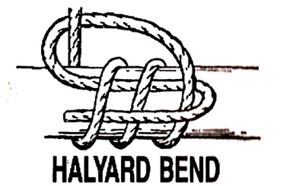
Halyard bend: Similar to the [Fisherman’s Bend], except that the end is tucked under the first round turn; this is more snug.

The Miller’s Knot:is a fairly good Binding Knot that is often given in farm bulletins. Any of the Miller’s Knots may employ a bight or loop for the final tuck instead of an end. This makes slipknots of them and saves the bag from being injured when the cord is being cut.

Fisherman’s Eye Knot: of the several knots known as True Lover’s Knot. It is a useful loop knot tied in the bight by one of at least four different methods. Once much used for the middleman on a rope in climbing, but now superseded for this purpose by better knots such as the Alpine Butterfly. Also used by anglers to make a leader loop, however there are also better knots for this purpose such as the Angler’s Loop. Also known as Middleman’s Knot, Fisherman’s Loop, Englishman’s Loop and True Lover’s Knot.

Midshipman’s Hitch: The Midshipman’s Hitch is an excellent knot to create an adjustable loop at the end of a rope. The knot can be slid up and down the standing line to increase or decrease the size of the loop (and thus the length and/or tightness of the standing line) but when load is applied the knot holds securely.
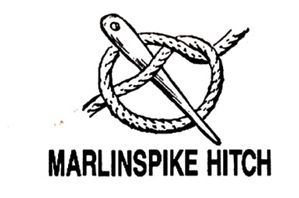
Marlinspike Hitch: The marlinespike hitch is a temporary knot used to attach a rod to a rope in order to form a handle.This allows more tension than could be produced comfortably by gripping the rope with the hands alone. It is useful when tightening knots and for other purposes in ropework.

Overhand Knot: The overhand knot is one of the most fundamental knots, and it forms the basis of many others, including the simple noose, overhand loop, angler’s loop, reef knot, fisherman’s knot, half hitch, and water knot. The overhand knot is a stopper, especially when used alone, and hence it is very secure, to the point of jamming badly. It should be used if the knot is intended to be permanent. It is often used to prevent the end of a rope from unraveling.

Killick Hitch: The killick hitch is a type of hitch knot used to attach a rope to oddly shaped objects. This knot is also known as the kelleg hitch. It is a combination of a timber hitch tied in conjunction with a half hitch, which is added to lend support and stability when pulling or hoisting objects. The addition of a half-hitch in front of the timber hitch creates a timber hitch and a half hitch, known as a killick hitch when at sea.

Hitching Tie: The hitching tie is a simple knot used to tie off stuff sacks that allows quick access as it unties quickly. To untie the knot, just pull hard on the free end of the rope and the knot will fall open. This is simply a noose or slip knot, with the loop tightened around an object. This is not a very strong knot for climbing or other extreme activities.

Half Hitch: The half hitch is a simple overhand knot, where the working end of a line is brought over and under the standing part. Insecure on its own, it is a valuable component of a wide variety of useful and reliable hitches, bends, and knots.

Granny Knot: The granny knot is a binding knot, used to secure a rope or line around an object. It is considered inferior to the reef knot (square knot), which it superficially resembles. Neither of these knots should be used as a bend knot for attaching two ropes together.

Fisherman’s Bend: a knot made by taking a round turn on the object to which the rope is to be fastened, passing the end of the rope around the standing part and under the round turn, and securing the end.

Double Carrick Bend: A type of knot used to fasten two cables or hawsers together.

Figure Eight Knot: The figure-eight knot or figure-of-eight knot is a type of stopper knot. It is very important in both sailing and rock climbing as a method of stopping ropes from running out of retaining devices. Like the overhand knot, which will jam under strain, often requiring the rope to be cut, the figure-eight will also jam, but is usually more easily undone than the overhand knot.

Sheet Bend Double: When lines are of unequal diameter or rigidity it is necessary for security to “double” the sheet bend by making an additional round turn below the first and again bringing the working end back under itself. The free ends should end up on the same side of the knot for maximum strength.
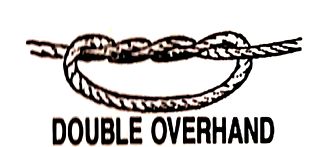
Double Overhand Knot:

Fisherman’s Knot:
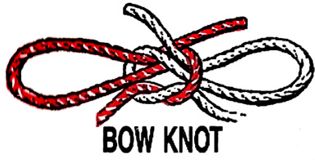
Bow Knot:
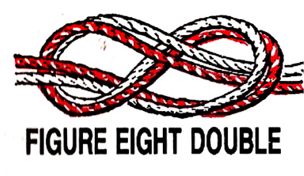
Figure Eight Double:
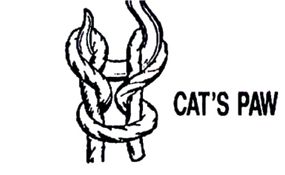
Cats Paw Knot:
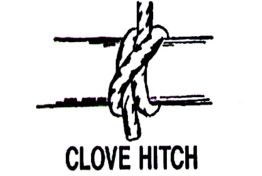
Clove Hitch:

Bowline on Bight:

Blackwall Hitch:
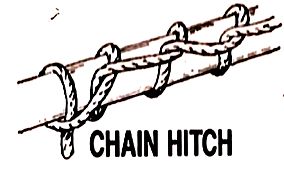
Chain Hitch:

Blackwall Hitch:
